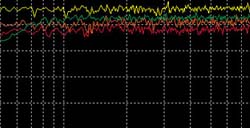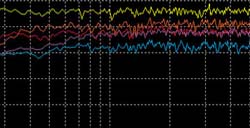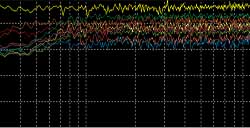
So far we have seen some simple techniques that likely minimise artifact/digital noise production when attenuating noise in a recording:
- Reduce the frequency range of the recording - done: low-pass filtering.
- Reduce the intensity of transient responses/ high frequencies in loud passages - done: dynamics processing.
- Decrease the spectral resolution of the CNF/FFT by reducing the FFT size (Eg., reduce the number of filter bands by using FFT sizes of 1024, 512 or smaller) - less noise reduction.
- Increase the FFT threshold at higher frequency bands (lose more high frequencies).
- Reduce the FFT attenuation of trapped frequency bands (less noise reduction).
So the problem is one of balance:
reduce surface noise more - lose transient responses, high frequencies and introduce more artifacts/digital processing errors.
reduce surface noise less - retain more high frequencies, introduce fewer digital artifacts but probably wont be happy with something that sounds like the original!
What happens if we try all three options available?
Below is a series of simple noise reduction tests involving broadband white noise generated using the "make waves" function in DC8. The first of the two images shows a series of single FFT passes and their effect on white noise attenuation (tests 1,2 and 3) whilst the second compares these to multiple FFT passes and the original noise signal (tests 1,2 4 and 5). The tests were as follows:
- A single 2048 FFT pass with 18dB noise attenuation (default threshold as set by DC8 except at the extremes as shown).
- A single 1024 FFT pass with 18dB attenuation (using threshold from test 1).
- A single 512 FFT pass with 18dB attenuation (using threshold from test 1).
- Consecutive FFT passes, firstly 2048 with 9dB attenuation (using threshold from test 1), followed by 1024 with 9dB attenuation (using threshold of test 1 reduced by 8dB).
- Consecutive FFT passes, firstly 1024 with 9dB attenuation (using threshold from test 1), followed by 512 with 9dB attenuation (using threshold of test 1 reduced by 9dB).

What can be observed is that the requested 18dB reduction in noise is not achieved with a signal FFT pass (unless the threshold were set unreasonably high). However, on subsequent passes (equivalent noise threshold and attenuation) the FFT appears to be considerably more effective. Whilst this is not an exact test, it still highlights the possibility that two smaller consecutive passes of the FFT may be better than one significantly attenuating single pass. So how does it sound?
| Test: | Filter/Notes | Settings | Sample File (wav) | File (mp3) |
| 1. | Original, 12kHz 12dB roll-off | wav | mp3 | |
| 2. | 2048 FFT 18dB Attenuation |  |
wav | mp3 |
| 3. | 1024 FFT 18dB Attenuation |  |
wav | mp3 |
| 3. | 512 FFT 18dB Attenuation |  |
wav | mp3 |
| 4. | (a)2048 FFT 9dB, (b)1024 FFT 9dB Attenuation |   |
wav | mp3 |
| 5. | (a)1024 FFT 9dB, (b)512 FFT 9dB Attenuation |   |
wav | mp3 |
Which sounds better? My preference is for 2048 FFT bin size followed by 1024. Whilst it is hard to determine if there is more or less digital artifact generation compared to the other tests, there is certainly a noticeable and measurable difference in the overall noise reduction.



